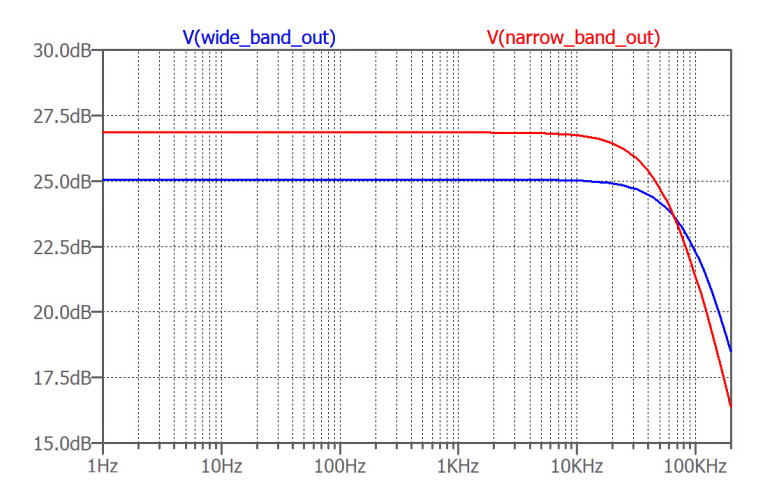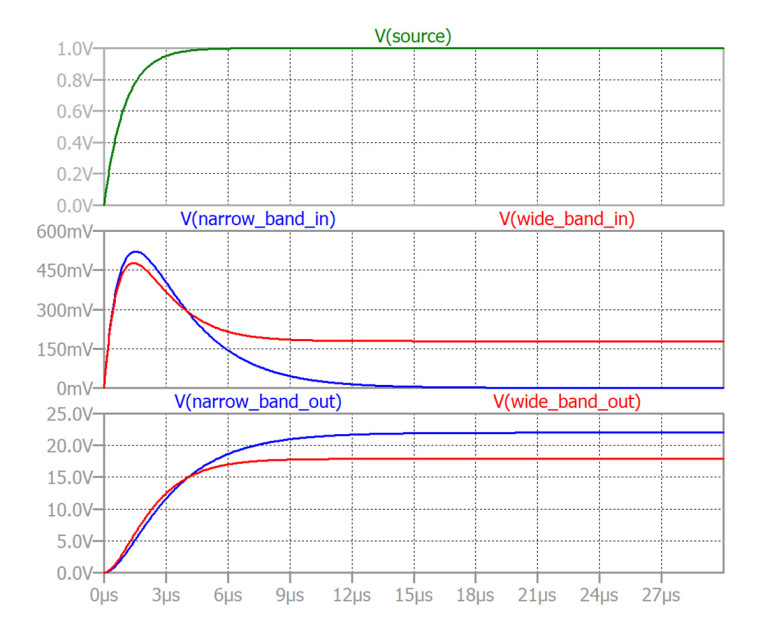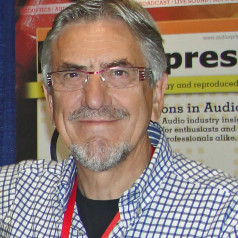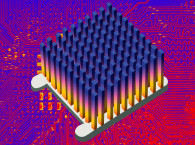But we might also be interested in what happens in the two cases in the time domain as a response to, say, a transient signal. Maybe all is fine frequency-wise, but not amplitude-wise. Let’s take a look.

I slightly modified my test circuits (Figure 1) by setting R3 and R6 to equal values. With that, both circuits have the same demanded gain so we can also evaluate the gain error of each circuit. (In the previous installment, I set R3 and R6 to values for equal output signal levels because at that time we were interested in input versus output signal levels).
Measured open loop, the two circuits are the same as we previously used. Measured closed loop, Figure 2, we see - as predicted by theory - that the wideband circuit is a bit anemic and falls short of the demanded closed-loop gain due to its limited open-loop gain. The demanded gain is R3/R5 + 1 (or R6/R2 + 1), which is 23 times or 27dB. The narrowband version has a gain of 26.85dB, which translates to 22 times, while the wideband version has a gain of 25.05dB, equivalent to 17.9 times. (In itself, that’s not really a problem; we can always adjust the feedback resistor for any reasonable gain we want).


Now let’s have some fun with transient input. I specified an exponential input source pulse signal to LTspice as EXP(0 1 0 50µ 1µ), which means a signal that starts at 0V at time zero, then exponentially rises to 1V with a τ (RC time constant) of 3µS, stays there for 50µS then falls at the same rate (not shown). We will look at the rising edge of the signal at the input stage of the circuit because that’s where you see the error signal. We are interested in the overshoot of that signal.
The reasoning is that when the source signal rises faster than the amp can follow, the output signal will fall short and the output of the feedback network will also fall short, and the difference between the source and feedback, which is the input stage signal, will increase as well. In the control systems world, that signal is called the error signal, because it would be zero with an infinite gain and infinite bandwidth amplifier. Since we are dealing with two widely different circuits as to bandwidth, we may expect a widely different response to such fast pulses.

Starting at the top, this is the source transient signal with the exponential rise. If we look to the input stage input signals (middle graph), we see an initial overshoot, that eventually settles to the steady state level, which - as we noted already last week - is especially for the narrow band case, very low – the output signal divided by the DC open-loop gain.
At the bottom, we see the amp output signals; both circuits have a nice smooth output, that asymptotes to the steady-state output in less than a few tens of µS, with the narrow band case taking a bit more time. Because of the limited open-loop gain of the wideband amp, it falls a few decibels short of the 27dB demanded gain while the narrowband case comes very close. But what we really are after is the leading-edge error signals at the input stage, the middle graph in Figure 3. Perhaps counter intuitively (for me it is), the magnitudes of the error signals are very close [1]!

Combined with the results of my previous essay last week, there doesn’t seem to be a case to bash the narrow band amplifier in favor of the wideband amp for input stage distortion. As we saw earlier, in the narrow band case, input stage signal levels for audio band signals are always lower than in the wideband case, so would cause less input stage distortion. Excited with fast transients, input stage overshoot levels are very similar so would also not favor one or the other as to input stage distortion. The wideband case does have a larger gain error but that can be fixed by adapting its feedback resistor, so it’s not a real issue and can be ignored [2].
Comments invited: techeditor@audioxpress.com
[1] Someone may point out that overshoot is formally defined as the ratio of overshoot peak level to steady-state level. With that definition, the overshoot of the narrowband case is much higher than in the wideband case. But in absolute value, which is what matters when looking at input stage distortion, they are very similar.
[2] A lower gain, corrected or not, does mean there is less feedback available for distortion reduction etcetera, so the distortion will be a couple of decibels higher, the frequency response will have a bit more ripple and be a fraction narrower and the output impedance will be a couple of decibels larger, but we should not lose any sleep over that.
This article was originally published in The Audio Voice newsletter, (#427), June 22, 2023.







